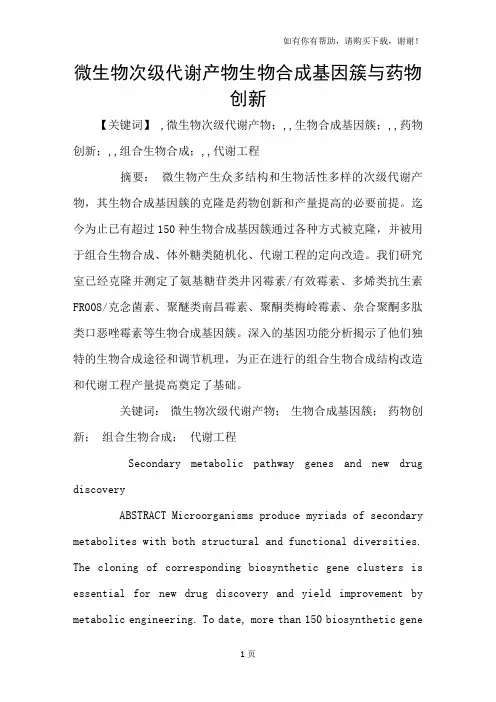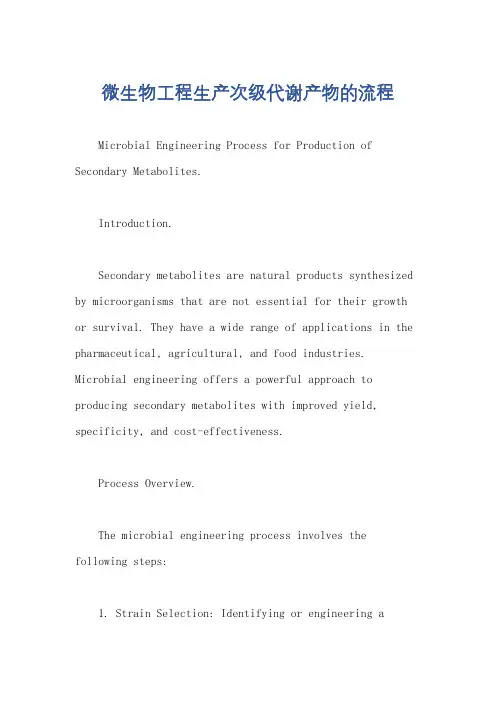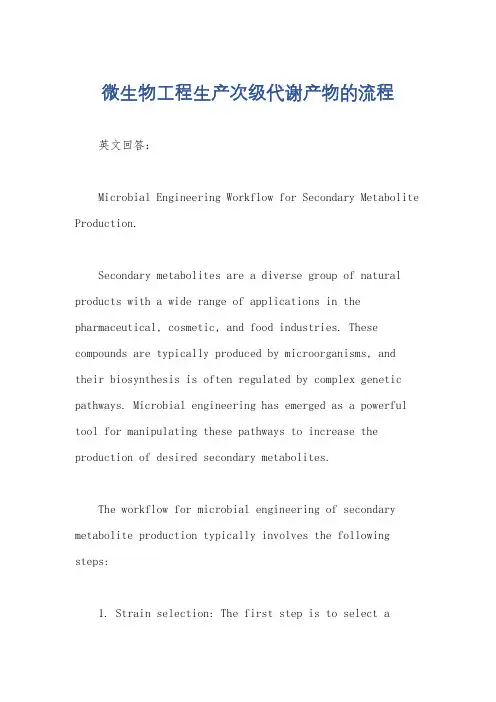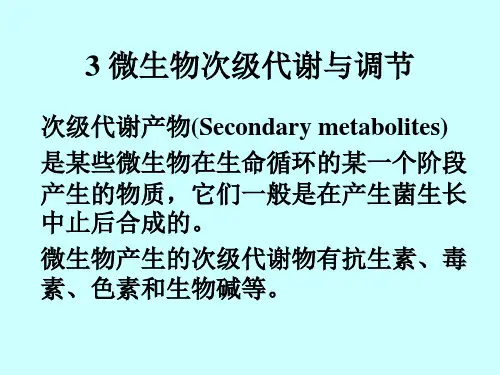微生物次级代谢产物
- 格式:docx
- 大小:20.74 KB
- 文档页数:1

微生物次级代谢产物生物合成基因簇与药物创新【关键词】 ,微生物次级代谢产物;,,生物合成基因簇;,,药物创新;,,组合生物合成;,,代谢工程摘要:微生物产生众多结构和生物活性多样的次级代谢产物,其生物合成基因簇的克隆是药物创新和产量提高的必要前提。
迄今为止已有超过150种生物合成基因簇通过各种方式被克隆,并被用于组合生物合成、体外糖类随机化、代谢工程的定向改造。
我们研究室已经克隆并测定了氨基糖苷类井冈霉素/有效霉素、多烯类抗生素FR008/克念菌素、聚醚类南昌霉素、聚酮类梅岭霉素、杂合聚酮多肽类口恶唑霉素等生物合成基因簇。
深入的基因功能分析揭示了他们独特的生物合成途径和调节机理,为正在进行的组合生物合成结构改造和代谢工程产量提高奠定了基础。
关键词:微生物次级代谢产物;生物合成基因簇;药物创新;组合生物合成;代谢工程Secondary metabolic pathway genes and new drug discoveryABSTRACT Microorganisms produce myriads of secondary metabolites with both structural and functional diversities. The cloning of corresponding biosynthetic gene clusters is essential for new drug discovery and yield improvement by metabolic engineering. To date, more than 150 biosynthetic geneclusters had been cloned via different strategies, which are subsequently manipulated through combinatorial biosynthesis, in vitro glycorandomization, or other biotechnological methods. In our laboratory, several biosynthetic gene clusters have been cloned and sequenced, representatives of which are responsible for the biosyntheses of the aminoglycoside jinggangmycin/validamycin, polyene antibiotic FR008/candicidin, polyether nanchangmycin, polyketide meilingmycin, PKSNRPS oxazomycin and others. Extensive analyses of gene functions, their unique biosynthetic pathways and regulatory mechanisms have now paved the way for more rational structural modifications through combinatorial biosynthesis and yield improvements using metabolic engineering.KEY WORDS Microbial secondary metabolites; Biosynthetic gene cluster; New drug discovery; Combinatorial biosynthesis; Metabolic engineering微生物产生的次级代谢产物在化学结构和生物活性方面多种多样,主要的产生菌类群包括放线菌、芽孢杆菌、粘细菌、假单胞菌、蓝细菌、真菌等,其中已知抗生素的三分之二以上是以链霉菌为代表的放线菌产生的。



微生物工程生产次级代谢产物的流程Microbial Engineering Process for Production of Secondary Metabolites.Introduction.Secondary metabolites are natural products synthesized by microorganisms that are not essential for their growth or survival. They have a wide range of applications in the pharmaceutical, agricultural, and food industries. Microbial engineering offers a powerful approach to producing secondary metabolites with improved yield, specificity, and cost-effectiveness.Process Overview.The microbial engineering process involves the following steps:1. Strain Selection: Identifying or engineering asuitable host strain that can produce the desired secondary metabolite.2. Biosynthetic Pathway Engineering: Modifying the biosynthetic pathway to enhance production of the secondary metabolite.3. Strain Improvement: Optimizing the host strain for growth and metabolite production.4. Fermentation Optimization: Developing and optimizing the fermentation conditions for optimal metabolite production.5. Downstream Processing: Extracting and purifying the desired secondary metabolite from the fermentation broth.Strain Selection.The host strain for secondary metabolite production should possess specific characteristics, including:Ability to produce the desired metabolite.Compatibility with the desired genetic modifications.High growth rate and tolerance to fermentation conditions.Strains can be obtained from natural sources or engineered using techniques such as mutagenesis, gene knockout, and gene overexpression.Biosynthetic Pathway Engineering.The biosynthetic pathway is the sequence of enzymatic reactions that lead to the production of the secondary metabolite. Microbial engineering can be used to modify the pathway to improve yield or specificity. Strategies include:Overexpressing genes encoding key enzymes.Introducing heterologous genes from other organisms.Modifying enzyme regulation or expression levels.Strain Improvement.Strain improvement techniques optimize the host strain for growth and metabolite production. This can involve:Media optimization (e.g., carbon and nitrogen sources)。

微生物工程生产次级代谢产物的流程英文回答:Microbial Engineering Workflow for Secondary Metabolite Production.Secondary metabolites are a diverse group of natural products with a wide range of applications in the pharmaceutical, cosmetic, and food industries. These compounds are typically produced by microorganisms, and their biosynthesis is often regulated by complex genetic pathways. Microbial engineering has emerged as a powerful tool for manipulating these pathways to increase the production of desired secondary metabolites.The workflow for microbial engineering of secondary metabolite production typically involves the following steps:1. Strain selection: The first step is to select asuitable microbial strain that is capable of producing the desired secondary metabolite. This may involve screening strains from natural sources or using genetically modified strains.2. Pathway elucidation: The next step is to elucidate the biosynthetic pathway for the secondary metabolite. This involves identifying the genes and enzymes involved in the pathway, as well as their regulatory mechanisms.3. Genetic engineering: Once the biosynthetic pathway has been elucidated, genetic engineering techniques can be used to manipulate the pathway to increase the production of the desired secondary metabolite. This may involve overexpressing genes encoding key enzymes, deleting genes that inhibit production, or introducing genes from other organisms that encode desired enzymes.4. Culture optimization: Once the microbial strain has been engineered, the culture conditions can be optimized to maximize secondary metabolite production. This may involve optimizing the growth medium, temperature, pH, and otherfactors.5. Downstream processing: The final step is to extract and purify the secondary metabolite from the culture broth. This may involve a variety of techniques, such asfiltration, chromatography, and crystallization.中文回答:微生物工程生产次级代谢产物的流程。


次级代谢产物的特征次级代谢产物是生物体在代谢过程中产生的非必需物质,通常被认为是与原代谢产物不同的化合物。
它们在生物体内起到了许多重要的生理和生态作用,如保护植物免受捕食者和病原体的侵害、吸引异性动物进行授粉、调节植物生长和发育等。
以下是次级代谢产物的一些特征:1. 次级代谢产物通常是有机化合物,包括多种类别,如酚类、醛类、酮类、酯类、碱类等。
2. 次级代谢产物不是必需的营养成分,与维持生命无关。
这些化合物通常不参与基本的代谢反应,而是在特定条件下被合成或释放出来。
3. 次级代谢产物具有高度结构多样性和复杂性。
它们可以由单个基本单元组成(如异戊烯),也可以由复杂的多环结构组成(如黄酮类)。
4. 次级代谢产物存在于各种生命形式中,包括植物、真菌、微生物和动物等。
它们在生物体内的含量和种类通常受到环境和遗传因素的影响。
5. 次级代谢产物具有广泛的生态作用。
它们可以用于吸引授粉者、抑制或引起捕食者对宿主的兴趣、调节植物生长和发育等。
此外,许多次级代谢产物还具有药理活性,可以作为药物或其他医疗用途。
6. 次级代谢产物通常是由特定酶系统合成的。
这些酶系统通常受到基因表达调控的影响,从而使得次级代谢产物在不同组织和环境中的含量和种类发生变化。
7. 次级代谢产物具有高度可塑性。
它们可以通过基因突变、环境胁迫等方式进行快速适应,从而使得生命体在不同环境中具有更好的适应性。
总之,次级代谢产物是生命体中重要的非必需化合物,在生态系统中扮演着重要角色。
它们具有高度结构多样性和复杂性,并且受到遗传和环境因素共同影响。
对于次级代谢产物的研究有助于深入了解生命体的适应性和进化机制,同时也为开发新药物和改善生态环境提供了新思路。


微生物次级代谢产物生物合成基因簇与药物创新一、概述微生物在生长过程中,除了进行维持生命活动所必需的初级代谢外,还会产生一系列复杂的次级代谢产物。
这些物质通常具有多样的化学结构和生物活性,包括抗生素、毒素、激素、色素等,对微生物自身并无明确的生理功能,但对人类和其他生物体可能具有显著的生物活性。
微生物次级代谢产物一直是药物研发的重要来源之一。
近年来,随着基因组学、转录组学、蛋白质组学等技术的飞速发展,研究者们开始从分子水平深入探索微生物次级代谢产物的生物合成机制。
生物合成基因簇的研究成为了热点之一。
生物合成基因簇是指一组在染色体上连续排列的基因,它们共同负责某一特定次级代谢产物的生物合成。
这些基因包括结构基因、调节基因、耐药性基因和转运蛋白等,它们之间具有复杂的调控关系,共同构成了微生物次级代谢产物生物合成的分子基础。
在药物创新方面,微生物次级代谢产物生物合成基因簇的研究具有重要的意义。
通过对生物合成基因簇的克隆和分析,可以深入了解次级代谢产物的生物合成途径和调控机制,为药物的设计和合成提供新的思路和方法。
通过基因工程手段对生物合成基因簇进行改造和优化,可以实现次级代谢产物的定向生产和产量提高,为药物的规模化生产提供可能。
利用生物合成基因簇的多样性,还可以发掘新的次级代谢产物,为药物创新提供更多的候选物质。
微生物次级代谢产物生物合成基因簇与药物创新之间存在着密切的联系。
通过对生物合成基因簇的深入研究,不仅可以揭示微生物次级代谢产物的生物合成机制,还可以为药物创新提供新的思路和方法。
未来,随着技术的不断进步和研究的深入,微生物次级代谢产物生物合成基因簇在药物创新领域的应用前景将更加广阔。
1. 微生物次级代谢产物概述微生物,作为地球上最古老且多样的生命形式,它们在生物地球化学循环和生物合成过程中发挥着至关重要的作用。
微生物的代谢活动不仅限于维持其生命活动所必需的主要代谢过程,还包括一种称为次级代谢的过程。


微生物次级代谢产物特点、作用及应用概况一、微生物次级代谢产物概况1、微生物次级代谢产物的定义及特点在微生物的代谢活动中,通常将微生物在一定生长时间内,以初级代谢产物为前体,合成一些对当前生命活动无明确功能物质的过程称为微生物次级代谢,代谢合成的物质称为微生物次级代谢产物。
微生物次级代谢产物大多是分子结构较复杂的化合物,因微生物和培养条件的不同,代谢产物也不尽相同。
通常次级代谢产物是被分泌到细胞外,在与其他生物竞争的过程中起重要作用。
但次级代谢产物不参与细胞结构的组成,也不是酶活性所必需的,即使在某个环节发生障碍,也不会致使机体停止生长或死亡。
微生物次级代谢产物被广泛应用于农业、食品和医疗等领域,前景广阔。
2、微生物次级代谢产物的来源微生物种类多、分布广,其次级代谢产物数量众多,来源广泛。
与人类生活密切相关的次级代谢产物主要来源于细菌、真菌和放线菌等。
部分微生物次级代谢产物来源及作用见表1。
(1)细菌细菌随处可见,其生物量仅次于植物体总生物量。
细菌代谢产物具有结构多样性和广谱活性,被广泛应用于农化和医药产品的制造。
研究表明:细菌中芽抱杆菌属产生的抗菌性代谢产物,如杆菌霉素、双效菌素及抗霉菌枯草杆菌素等,被广泛应用于作物病害防治中,γ-聚谷氨酸具有较强的抗逆促生作用,被广泛应用于新型肥料生产;假单胞菌属产生的代谢产物,如2 , 4-二乙酰基间苯三酚、硝咙咯菌素等,是目前被研究最多的细菌生物防治剂。
(2)真菌真菌具有生物多样性,种类和数量众多,目前已了解的真菌种类有9. 7万余种,但仅占其种类数量的6%。
在真菌微生物次级代谢产物中,约50%是由丝状真菌产生的。
研究表明,木霉菌、非致病性濂刀菌和聚端孢霉等是少数能够产生多种抗菌代谢产物的真菌属。
木霉菌能够产生木霉素和杀病毒剂等抗生素次级代谢产物;厚垣镰孢的次级代谢产物能够有效抑制花生锈病病原菌的产生;粉红聚端孢菌能够产生大量抗病毒次生代谢产物和具有农药活性的抗生菌;单端孢菌素作为粉红聚端孢菌的产物被广泛用于棉籽枯萎病的防治。
微生物代谢物
微生物代谢产物的种类很多,已知的有37个大类,其中16类属于药物。
在菌体对数生长期所产生的产物,如氨基酸、核并酸、蛋白质、核酸、糖类等,是菌体生长繁殖所必需的。
这些产物叫做初级代谢产物,许多初
级代谢产物在经济上具有相当的重要性,分别形成了各种不同的发酵工业。
在菌体生长静止期,某些菌体能合成一些具有特定功能的产物,如抗
生素、生物碱、细菌毒素、植物生长因子等。
这些产物与菌体生长繁殖无
明显关系,叫做次级代谢产物。
次级代谢产物多为低分子量化合物,但其
化学结构类型多种多样,据不完全统计多达47类,其中抗生素的结构类型,按相似性来分,也有14类。
由于抗生素不仅具有广泛的抗菌作用,
而且还有抗病毒、抗癌和其他生理活性,因而得到了大力发展,已成为发
酵工业的重要支柱。
微生物次级代谢产物
微生物在次级代谢过程中产生的产物称次级代谢产物。
包括:抗生素,毒素,生长剌激素,色素和维生素等。
次级代谢产物是指微生物生长到一定阶段才产生的化学结构十分复杂、对该微生物无明显生理功能,或并非是微生物生长和繁殖所必需的物质,如抗生素。
毒素、激素、色素等。
不同种类的微生物所产生的次级代谢产物不相同,它们可能积累在细胞内,也可能排到外环境中。
其中,抗生素是一类具有特异性抑菌和杀菌作用的有机化合物,种类很多,常用的有链霉素、青霉素、红霉素和四环素等。